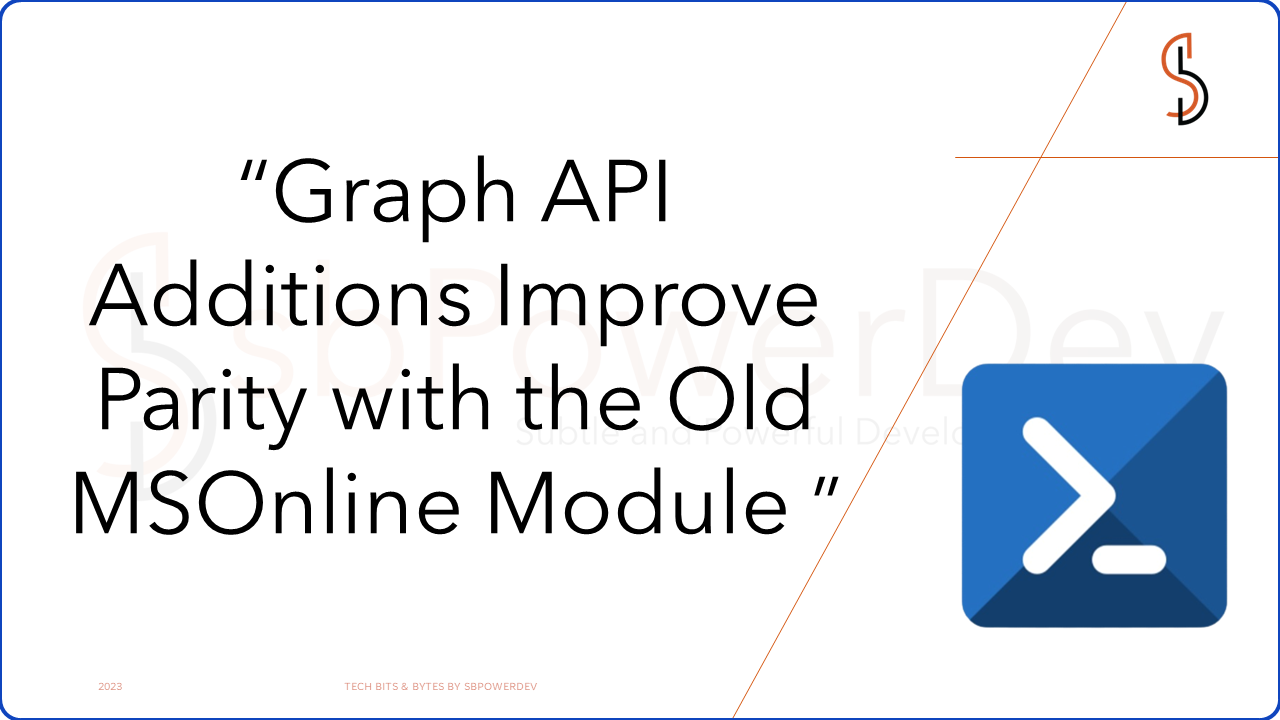
In Microsoft 365 and Azure administration, managing resources, users, and configurations efficiently is paramount. Administrators have used the MS Online module to interact with Microsoft services programmatically for years. However, as technology evolves, so do the tools available for managing these services. Enter the Microsoft Graph API, a versatile and powerful platform for accessing data and managing resources in the Microsoft ecosystem. In this blog post, we will explore how Graph API additions have closed the gap with the old MS Online module, offering enhanced capabilities and improved parity for administrators.
The Transition from MS Online to Graph API
The MS Online module, the Azure Active Directory PowerShell module, has long been a go-to choose for administrators managing Azure AD and other Microsoft services. While it provided essential functionalities, it was limited and primarily focused on Azure AD operations.
The transition to the Microsoft Graph API began to address these limitations and provide a unified interface for managing various Microsoft 365 and Azure services. Over time, Microsoft has invested heavily in the Graph API, expanding its capabilities to cover a broader range of scenarios.
Improved Parity with Graph API Additions
- User Management: Managing user accounts is a fundamental task for administrators. With the Graph API, you can perform a wide range of user management operations, including creating, updating, and deleting users, assigning licenses, and resetting passwords. These operations are now on par with what was possible with the MS Online module.
- Group Management: Groups are crucial for organising users and resources. The Graph API allows you to create and manage security groups, distribution lists, and Microsoft 365 groups, making it a powerful tool for group management tasks.
- Azure Resources: The Graph API has expanded its capabilities to cover Azure resources like virtual machines, storage accounts, and databases. You can now use a single API to manage identity-related tasks and infrastructure resources.
- Conditional Access Policies: Conditional Access is a vital security component in Azure AD. Graph API additions have made it possible to define and manage dependent access policies programmatically, giving administrators greater control over security configurations.
- Reporting and Insights: The Graph API provides access to a wealth of reporting and auditing data, allowing administrators to gain insights into user activities, sign-in events, and more. This level of visibility could have been improved in the old MS Online module.
- Consistency Across Services: One of the most significant advantages of the Graph API is its consistency across various Microsoft services. Whether you’re managing Azure AD, Microsoft Teams, SharePoint, or Exchange, the same API can be used, simplifying script development and maintenance.
- Improved Authentication: One significant area of improvement is in authentication methods. The Graph API now supports more robust authentication options, making connecting securely to your Microsoft services easier. For instance, the MSAL (Microsoft Authentication Library) can authenticate users and applications, providing enhanced security and flexibility.
- Unified Endpoint: The Graph API offers a suitable endpoint for accessing Azure AD and Office 365 resources, eliminating the need to switch between different modules. This simplifies administrative tasks and streamlines management.

- Extensive Resource Coverage: The Graph API now covers a broader range of resources and functionalities, mirroring the capabilities of the old MS Online module. This expansion includes managing SharePoint, OneDrive, Exchange, and more.
- Consistent Naming Conventions: With the improvements, the Graph API follows consistent naming conventions, making it easier to transition from the old MS Online module. For instance, operations for managing users and groups now use similar cmdlets and parameter names.
- Enhanced Error Handling: The Graph API provides more informative error messages, making troubleshooting and debugging more straightforward. This helps administrators pinpoint issues and resolve them faster.

Challenges and Considerations
While the Microsoft Graph API offers significant advantages, there are a few considerations and challenges to keep in mind:
- Authentication: Proper authentication and authorisation are crucial when using the Graph API. Administrators must understand the various authentication methods available and choose the one that best fits their needs.
- Learning Curve: Transitioning from the MSOnline module to the Graph API may require administrators to learn new concepts and adapt their scripts. Microsoft provides extensive documentation and resources to assist with this learning process.
- Rate Limiting: The Graph API enforces rate limits to prevent abuse. Administrators should know these limits and implement appropriate error handling in their scripts.
Conclusion
The Graph API has come a long way in improving parity with the old MS Online module. With its expanded capabilities, consistency across services, and enhanced user and resource management features, it has become the preferred choice for many administrators. While there may be a learning curve and authentication considerations, the benefits of using the Graph API are clear, offering a powerful and unified platform for managing Microsoft 365 and Azure services efficiently.
As technology evolves, administrators need to stay updated with the latest tools and resources to manage their environments effectively. The Microsoft Graph API represents a significant step forward, providing a robust foundation for future-proof administration.















